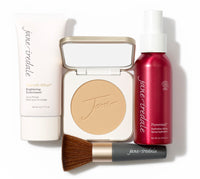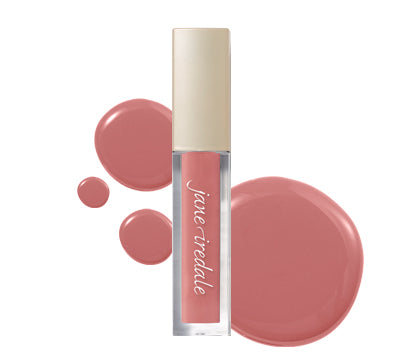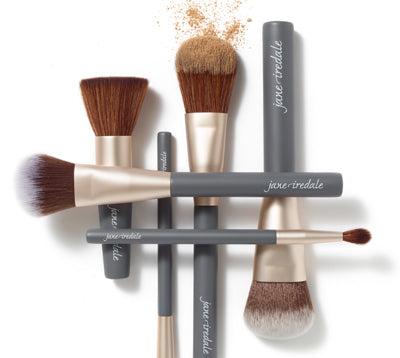Let's talk about the ever-beautiful rose. It's used in almost as many ingredient formulations as it has petals. From extracts to waxes, if you look at our Ingredient Library, you'll see over five different types of rose ingredients. That's because roses aren't just beautiful, they have serious skincare benefits.
 The rosehip fruit extract used in our BeautyPrep Face Toner and BeautyPrep Face Moisturizer is grown from organic farming. Rosehip fruit extract helps hydrate your skin, protect from trans-epidermal water loss, brighten your skin, and much more. Active-Light Uner-Eye Concealer also contains rosehip fruit extract.
The rosehip fruit extract used in our BeautyPrep Face Toner and BeautyPrep Face Moisturizer is grown from organic farming. Rosehip fruit extract helps hydrate your skin, protect from trans-epidermal water loss, brighten your skin, and much more. Active-Light Uner-Eye Concealer also contains rosehip fruit extract.
 The version of "rose stem cell extract" we use in BeautyPrep Face Moisturizer contains four different organic, rose stem cell extracts:
The version of "rose stem cell extract" we use in BeautyPrep Face Moisturizer contains four different organic, rose stem cell extracts:
 HandDrink Hand Cream includes rose flower oil to hydrate and soothe your skin. It calms, nourishes and conditions, just what you want to have in a hand cream. Not only does the oil lend a beautiful, soft fragrance to the cream, it also protects your skin against water loss during the cold, dry winter.
HandDrink Hand Cream includes rose flower oil to hydrate and soothe your skin. It calms, nourishes and conditions, just what you want to have in a hand cream. Not only does the oil lend a beautiful, soft fragrance to the cream, it also protects your skin against water loss during the cold, dry winter.
 What is rose flower wax? Well, it's just what it sounds like, a wax created from the Damask Rose. It's antioxidant-rich, helping to fight free radical damage and found in our Just Kissed Lip & Cheek Stains (as if you didn't already love your Forever Pink). Rose flower wax also protects, conditions and soothes your lips, while giving the formula a light, luxurious scent.
What is rose flower wax? Well, it's just what it sounds like, a wax created from the Damask Rose. It's antioxidant-rich, helping to fight free radical damage and found in our Just Kissed Lip & Cheek Stains (as if you didn't already love your Forever Pink). Rose flower wax also protects, conditions and soothes your lips, while giving the formula a light, luxurious scent.
How do I Know if Roses are Used?
First, let's talk about how to identify a rose flower ingredient. Sometimes you'll see the word "rose" in parenthesis, but usually, a botanical ingredient is identified by its genus and species (high school biology strikes again). The genus for roses is Rosa, and the species varies by the type of rose. In our products, you'll typically see Rosa Alba, Rosa Canina, or Rosa Damascena listed.Roses & Skincare Benefits
Every rose ingredient that we use has a slightly different skincare benefit. Water and extracts obtained from the petals and flowers of various rose species are used for antioxidant, anti-irritant, and skin-conditioning. Rose oils and waxes have moisturizing benefits. Not to mention, any product that contains a rose ingredient has a delightful scent.Rosehip Fruit Extract
 The rosehip fruit extract used in our BeautyPrep Face Toner and BeautyPrep Face Moisturizer is grown from organic farming. Rosehip fruit extract helps hydrate your skin, protect from trans-epidermal water loss, brighten your skin, and much more. Active-Light Uner-Eye Concealer also contains rosehip fruit extract.
The rosehip fruit extract used in our BeautyPrep Face Toner and BeautyPrep Face Moisturizer is grown from organic farming. Rosehip fruit extract helps hydrate your skin, protect from trans-epidermal water loss, brighten your skin, and much more. Active-Light Uner-Eye Concealer also contains rosehip fruit extract.
Rose Stem Cell Extract
 The version of "rose stem cell extract" we use in BeautyPrep Face Moisturizer contains four different organic, rose stem cell extracts:
The version of "rose stem cell extract" we use in BeautyPrep Face Moisturizer contains four different organic, rose stem cell extracts:
- White Rose supports natural cell regeneration and the skin barrier. It also helps to restore the appearance of suppleness to your skin.
- Damask Rose helps to tighten pores, purify and smooth your skin.
- Rosa Canina (Rosehips) calms and brightens skin and helps prevent trans-epidermal water-loss.
- Pale Rose helps to rebuild the moisture barrier and provide skin suppleness for the appearance of newer, softer skin.
Rose Flower Oil
 HandDrink Hand Cream includes rose flower oil to hydrate and soothe your skin. It calms, nourishes and conditions, just what you want to have in a hand cream. Not only does the oil lend a beautiful, soft fragrance to the cream, it also protects your skin against water loss during the cold, dry winter.
HandDrink Hand Cream includes rose flower oil to hydrate and soothe your skin. It calms, nourishes and conditions, just what you want to have in a hand cream. Not only does the oil lend a beautiful, soft fragrance to the cream, it also protects your skin against water loss during the cold, dry winter.
Rose Flower Wax
 What is rose flower wax? Well, it's just what it sounds like, a wax created from the Damask Rose. It's antioxidant-rich, helping to fight free radical damage and found in our Just Kissed Lip & Cheek Stains (as if you didn't already love your Forever Pink). Rose flower wax also protects, conditions and soothes your lips, while giving the formula a light, luxurious scent.
What is rose flower wax? Well, it's just what it sounds like, a wax created from the Damask Rose. It's antioxidant-rich, helping to fight free radical damage and found in our Just Kissed Lip & Cheek Stains (as if you didn't already love your Forever Pink). Rose flower wax also protects, conditions and soothes your lips, while giving the formula a light, luxurious scent.








